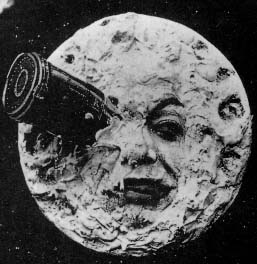The film is pretty poor, frankly. Yes, it's groundbreaking, it has great special effects for its time and fantastical sets. It's also admirably ambitious. Where other film makers were content with replicating a stage play on the big screen, Georges Méliès made a science fiction movie with aliens and rocket ships. I recommend you all watch it as it's an intriguing bit of film history but, as a film, it's pretty terrible. The plot is nonsense and just involves a bunch of magicians flying to the moon, killing off some natives and falling back to earth. It's cartoonish but not in a good way.
There isn't really any acting to speak of, either. Part of this might be down to the narrative style of the film being so alien — directors hadn't yet learned the language of cinema and how to tell a story in the new medium. There are no close-ups — just a static camera sitting away from the action as if we're in the front row of the theatre. There's no voice acting either (duh) so there's no way for the actors to express themselves other than jumping around and pointing at things — you don't see their faces. It just feels very clunky.
It does have one glorious moment, though, and that's the iconic image we've all seen before of the rocket flying into the moon's eye. It's worth it for that at least.

It's not the oldest film I've seen, though. That would be this. Cool to say you've seen it, but that's as far as it goes. Why is the old woman in the background walking backwards, though?
Finally took the few minutes to watch this. I think you're a bit harsh on it - it's not particularly advanced, but you have to bear in mind that in those days they couldn't move cameras around easily and probably couldn't afford the editing time required to insert close-ups. The plot is simplistic, but probably appealing to the masses, and, as you say, the visual effects are great for the time. The Avatar of its day?
ReplyDeleteI don't know what happens at the end, though - the live action seemed to stop only to be replaced by a couple of still photos to show the astronauts' arrival home. There may be a complete version out there somewhere.
Although dated now, you can see how Méliès' style influenced a lot of film-makers. Watching it, I was immediately reminded of Terry Gilliam's animations, and also of his film of Baron Munchausen (maybe because of the costumes?). I looked up Méliès on IMDB, and among his extraordinarily prolific output, he made his own version of Munchausen, as well as Don Quixote - which of course Gilliam tried to make for years as well. It'd be interesting to know if Gilliam cites the Frenchman as an inspiration for his own work.
I think at the end those final stills are "deleted scenes" which were added later on from the original conceptual drawings. The film as it would have been shown finishes when the live action stops.
ReplyDeleteMy harsh comments were evaluating it as a piece of drama, but I agree (and did try to say) that as a historical work it's outstanding. I think you're on the money with the Avatar comparison. Should Avatar make it into a list of the greatest films of the 21st century it won't be because it's any good - far from it. It'll be because it was at the vanguard of 3D technology and visual effects and ushered in a new era. I'm sure this is why Star Wars is on this list, too. It's certainly not the 90th greatest film of the century, but its influence was enormous.
Interesting comments on Gilliam. The Baron von Munchausen does, of course, visit the moon and its inhabitants (Selenites?) too, so there's a definite similarity there. It also plays fast and loose with physics and a human's need to breathe.
Slightly off topic, I went through the list yesterday, looking up the several films I didn't know, trying to see who the most represented director was. Looks like Godard tops the list, with 8, or possibly 9. According to IMDb, #37 "My Life to Live" is merely the US title for #235 "Vivre sa Vie". So when you watch one you can cross off the other, too.
ReplyDeleteAlso, how the hell is Family Feud (#112) on the list? This is the game show known in the UK as Family Fortunes. I guess they don't have Blankety Blank in the US.
I did wonder about that, but hadn't looked into it. I assumed it was some sort of documentary about the TV show, or maybe a parody. As the entry only specifies the Richard Dawson-hosted episodes, that's just 2311 to watch before I can cross it off! That critic has some strange votes, though. He's responsible for Porky in Wackyland, for example.
ReplyDeleteGlad to hear the list is one shorter. Also, if you cross off The Apu Trilogy (54) you automatically cross off Pather Panchali (12), as it's one of the trilogy.